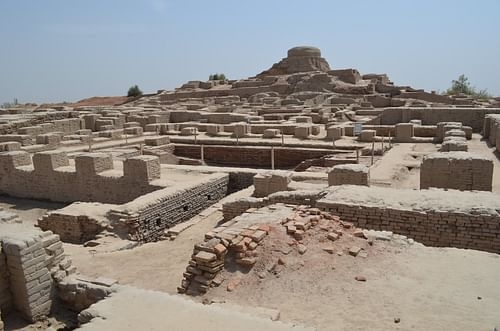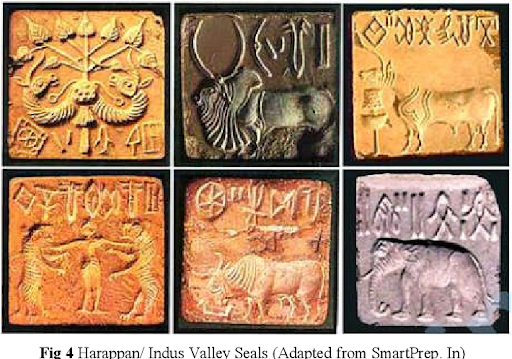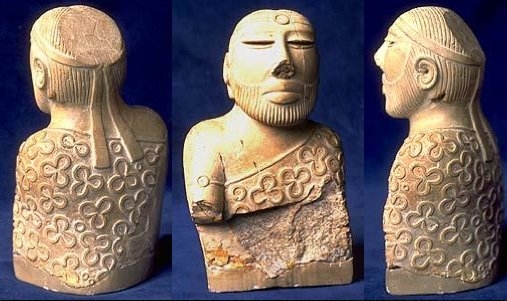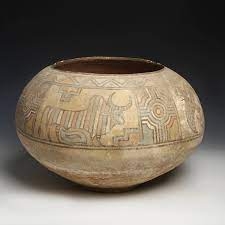Sindhu-Saraswati Civilization: ‘Our Own’ Legacy-I
09 May 2023 14:22:26
Whenever we go to any social or family gathering, we always observe some common practices or rituals i.e. all gather around and gossip about their own traditions which they follow in their own house or family. You will always hear this sentence in any family function, “we do this ritual like this” or “our family recipe is more yummy than this” or “our nanni makes the best ladoo in the world”. All these expressions are the expression of our own legacy, not only family legacy but also legacy as an individual family unit.

When as social-historical students like us started to draw the origin of our own legacy as Indians, the first sight of the origin of our legacy starts with “ Indus valley civilization” or in more accurate terms, “Sindhu-Saraswati Civilization”.
From its discovery to its latest Excavation report, Sindhu- Saraswati Civilization is a lighthouse of unique Indianness; its every aspect is directly or indirectly connected to day-to-day modern Indian Life.
Most importantly, the recent study of ‘Rakhigarhi’ site of Sindhu- Saraswati Civilization gave most important link of all the ruckus about ‘Aryan Invasion Theory’, this study indicates there is no strong foundation for long held ‘Aryan Invasion or Aryan Migration’ on Indian land.
The Tale of the Sindhu-Saraswati Civilization, therefore, is best given with the discovery of its ruins in the 19th century CE, discovery of this breathtaking civilization is also an accident.
James Lewis (better known as Charles Masson, l) was a British soldier serving in the East India Company Army when, in 1827 CE, he deserted with another soldier. To avoid detection by authorities, he changed his name to Charles Masson and embarked on a series of travels throughout India. Masson was an enthusiastic numismatist who was collecting old coins and, following various leads, ended up excavating ancient sites on his own. One of these sites was Harappa, which he found in 1829 CE. He left the site quickly, after making a record of it in his notes but, having no knowledge of who could have built the city, wrongly attributed it to Alexander the Great during his campaigns in India c. 326 BCE. The findings of Charles Masson attracted the attention of Alexander Cunningham.
Sir Alexander Cunningham, established ASI (Archeological Survey of India) with passion for ancient History. Cunningham began excavations of the site and published his interpretation in 1875 CE , in which he identified and named the Indus Script but this was incomplete and lacked definition because Harappa remained isolated with no connection to any known past Civilisation which could have built it.
In 1904 CE, a new director of the ASI John Marshall (l. 1876-1958 CE), who later visited Harappa and concluded the site represented an ancient Civilisation previously unknown. He ordered the site to be fully excavated and, at about the same time, He come to know of another site some miles away which the local people referred to as Mohenjo-Daro (“the mound of the dead'') because of bones, both animal and human, found there along with various artifacts.
Excavations at Mohenjo-Daro began in the 1924-1925 season and the similarities of the two sites were recognized; the Sindhu- Saraswati Civilization had been discovered.

In 1912, John Faithfull Fleet, a civil servant working with the Indian Civil Services, discovered several Harappan seals. This prompted an excavation campaign from 1921-1922 by Sir John Hubert Marshall, Director-General of the Archaeological Survey of India, which resulted in the discovery of Harappa.
By 1931, much of Mohenjo-Daro had been excavated, while the next director of the Archaeological Survey of India, Sir Mortimer Wheeler, led additional excavations.
The Partition of India, in 1947, divided the country to create the new nation of Pakistan. The bulk of the archaeological finds that followed was inherited by Pakistan.
Over 1400 Sindhu-Saraswati Civilization sites have been discovered, of which 925 sites are in India and 475 sites in Pakistan, while some sites in Afghanistan are believed to be trading colonies. The oldest site of the Bhirrana and the largest site, Rakhigarhi are located in Haryana.
More than 90% of the inscribed objects and seals that were discovered were found at ancient urban centers along the Indus river in Pakistan, mainly Harappa (Punjab) and Mohenjo-daro (Sindh). More than 50 IVC burial sites have been found, main sites among those are Rakhigarhi (first site with genetic testing), Sanauli, Farmana, Kalibangan, Lothal, Dholavira, Mehrgarh, Harappa, Chanhudaro, and Mohenjo-Daro.

The Time frame of this massively spread and modern compared to other civilizations of that era is 3300 BCE to 1300 BCE, some archeologists stretch this time frame till 800 BCE. As per established evidences, Early Harappan Phase from 3300 to 2600 BCE, the Mature Harappan Phase from 2600 to 1900 BCE, and the Late Harappan Phase from 1900 to 1300 BCE.
Main and important feature of the Sindhu- Saraswati Civilization is its seals. The Identity of Indus valley civilization is its artistry and its town planning which includes water ways, granary and smithy or Forges. The World’s first architectural planning of cities which are designed in grid and rectangular pattern with cross-roads which meet at the right angles.
Another interesting fact about this is, the first signboard of the world was found in this civilization. The people of this civilization are most aware about hygiene and cleanliness, which was evident in great baths of all the cities. The Great Bath of Mohenjo Daro was named as ‘First public water tank in the ancient world’.
These people were also the first cotton cultivators of the world. The world’s first traces of cotton are found in the site Alamgirpur, in Uttar Pradesh. It is also believed that these people know the art of spinning and weaving of cotton.
Most interestingly, the earliest evidence of Garlic is also found in this civilization.

The earliest, and the most important, sheltered harbor, which the Harappans developed into a large plaza and servicing station, is Lothal. Situated in a strategic location, it was the warehouse of the rich rice, cotton, and wheat-growing hinterland.
The wonderful drainage system is evidence of the earliest form of Municipal Organization. The mesmerizing accuracy of measurements and weights is another point of this civilization which makes it more special.
Another astonishing feature of this civilization is its script, Sindhu Script. This script is a reflection of literacy. The Sindhu Script is yet to be deciphered but it is clear that this script was used in commercial as well as daily life.
People of this civilization are game-lovers. They enjoy indoor as well as outdoor games. The excavation unearthed the stone dice of 2000 BCE, which they used for playing dice games like today. These people are the creators of the earliest board games of dice games.
But, who are these people? Where do they go? Where do they come from? What is their society? Culture? Religion? Are we connected to these people? What is our relationship with them? All these questions’ answers the greater question- WHO WE ARE?
“If civilization is to survive, we must cultivate the science of human relationships - the ability of all peoples, of all kinds, to live together, in the same world at peace.” – Franklin D. Roosevelt